Abstract
In response to the rising demand for sustainable engineering materials and waste valorisation strategies, this study investigates the multi-objective optimisation of eco-friendly hybrid composites reinforced with natural fibres and industrial waste. Sixteen composite specimens were fabricated using compression moulding by varying sisal fibre from 0 to 45 wt.%, banana fibre from 0 to 45 wt.%, NaOH alkali treatment from 0 to 6%, and red mud filler from 1 to 4 wt.%. Mechanical properties were evaluated following ASTM standards D256 for impact strength, D790 for flexural strength, D638 for tensile strength, D5379 for shear strength, and E18 for hardness. The Taguchi method combined with grey relational analysis was employed to identify optimal processing conditions. The best mechanical performance, with an impact strength of 6.57 J, flexural strength of 72.58 MPa, and tensile strength of 65.52 MPa, was achieved with 30 to 45 wt.% sisal fibre, 15 wt.% banana fibre, 6% NaOH, and 3 to 4 wt.% red mud. ANOVA revealed that NaOH treatment had the most significant influence on mechanical properties, with high F values and p values close to 0.05. Grey relational analysis proved more effective for multi-objective optimisation, with the highest grey grade of 0.894 observed in the specimen containing 45 wt.% sisal fibre, 6% NaOH, and 2 wt.% red mud. These findings highlight the critical role of fibre treatment and hybrid reinforcement in enhancing performance. The optimised composites demonstrate strong potential for use in automotive interior panel applications, offering a sustainable alternative with balanced strength and reduced environmental impact.
1. Introduction
The generation and disposal of industrial waste pose significant challenges to global sustainability efforts. Among these wastes, red mud, a highly alkaline by-product of the Bayer process used in aluminium refining, is one of the most voluminous and problematic []. According to recent reports, over 175 million tonnes of red mud are produced globally each year, and more than 4 billion tonnes have been stockpiled worldwide as of 2023 []. Improper management of red mud poses serious environmental threats due to its caustic nature (pH > 12), high heavy metal content, and long-term soil and groundwater contamination risks. Countries such as India and China, with large-scale aluminium production, are experiencing rising pressure to develop circular economy strategies to reuse this waste []. Despite its hazardous characteristics, red mud possesses favourable properties such as high iron oxide and alumina content, making it a potential functional additive in construction and composite materials. In recent years, research has increasingly focused on repurposing red mud to reduce the environmental footprint of manufacturing processes while also adding value to waste []. The integration of red mud into polymer composites remains underutilised, particularly in natural fibre-reinforced polymer composites (NFRPCs), which are a class of sustainable materials gaining traction as substitutes for synthetic fibre composites. NFRPCs made from banana and sisal fibres are biodegradable, lightweight, and derived from renewable agricultural sources. These fibres are widely available in tropical regions and possess high tensile strength and stiffness. Nevertheless, their hydrophilic nature often leads to poor fibre–matrix bonding. Surface modification through alkali treatment and hybridisation with fillers has been shown to improve their interfacial adhesion and mechanical performance. The sustainable incorporation of red mud as a filler in NFRPCs not only addresses the issue of industrial waste disposal but also enhances composite strength, wear resistance, and thermal properties.
The performance of hybrid composites is influenced by various factors such as fibre content, filler loading, and processing conditions. Determining the best combination of these variables is essential to achieving optimal mechanical and wear resistance. Traditional trial-and-error methods for optimisation are often time-consuming and inefficient. As an alternative, statistical approaches like the Taguchi method and grey relational Analysis (GRA) provide a more efficient and systematic means of parameter optimization []. The Taguchi approach helps streamline experiments by minimizing the number of trials required while still accounting for the influence of various input parameters. It employs orthogonal arrays to assess factor influence and identify suitable levels. However, the evaluation of composite performance is usually a multi-objective task, involving different and sometimes competing responses such as tensile, flexural, hardness, and wear rate. GRA simplifies multi-response optimisation by transforming several output variables into a single grey relational grade (GRG), thereby enabling single-objective decision-making. The main strengths of GRA lie in its capacity to handle multiple objectives, standardise variables with different units, and improve the decision-making process by ranking combinations based on overall performance. When integrated with the Taguchi method, GRA enhances optimisation accuracy while reducing experimental effort []. Despite these advancements, several important gaps still exist. While red mud offers significant potential as a functional filler, it remains underutilised in natural fibre composites. Furthermore, most existing works either do not optimise performance or consider only a single mechanical parameter. A comprehensive, multi-objective approach for optimising fibre/filler combinations, particularly with red mud, is lacking.
Poyyathappan et al. [] investigated the effect of drilling parameters on alkali–silane-treated areca fibre epoxy composites. Using the Taguchi–grey analysis, they identified silane concentration as the key factor influencing machinability. The optimised composite (AAS1, 4 w/v% silane) showed enhanced mechanical properties, while AAS2 (6 w/v% silane) achieved lower kerf width. SEM analysis confirmed improved fibre–matrix bonding, highlighting the importance of silane treatment for better drilling performance. Thangaraj et al. [] fabricated a hybrid composite by integrating short sisal and banana fibres (1–2 cm) with a polypropylene matrix and nano-sized marble powder (50–60 nm) through injection moulding. The addition of nano marble dust enhanced the composite’s flexural and impact strength and thermal conductivity and reduced its water absorption. However, the composite made only with banana and sisal fibres showed better tensile strength than those containing marble dust. Anbalagan et al. [] fabricated polyester-based composites reinforced with banana and sisal fibres in varied weight proportions such as 40:60, 50:50, and 60:40. The composite containing 40% banana and 60% sisal fibres demonstrated higher compressive strength, impact resistance, hardness, and heat transfer rate. In contrast, the sample with 60% banana and 40% sisal fibres absorbed more water. Kumari et al. [] used banana and sisal fibres along with sawdust as reinforcements in epoxy composites, prepared via hand lay-up with a resin-to-hardener ratio of 4:1. The composites included 20 wt.% reinforcing fibres and 80 wt.% matrix material. Their results indicated that adding more sawdust enhanced the mechanical strength, hardness, and water absorption capacity, suggesting the potential of these natural fibre composites to replace synthetic alternatives. Karthikeyan et al. [] explored the mechanical performance of composites reinforced with banana and sisal fibres, targeting applications in construction, automotive, and marine industries. They found that increasing the fibre content led to improvements in tensile and flexural properties. Devi et al. [] examined the effect of moisture on hybrid sandwich composites prepared of banana and sisal fibre woven fabrics, epoxy resin, and a polyethylene foam core. Although the foam improved overall mechanical strength, long-term water exposure reduced tensile, flexural, and impact performance due to moisture seeping into the fibre–matrix interface. Siva et al. [] produced a hybrid composite using banana and sisal fibres in a sandwich structure and compared its mechanical properties with those of single-fibre sisal–epoxy composite and banana–epoxy composites. Their results showed that the sisal/epoxy composite exhibited the superior flexural, tensile, and impact strengths among all configurations. Gupta et al. [] optimised hybrid banana–sisal composites by adjusting fibre loading and distribution. They created CAD models using CREO 5.0 software and conducted Finite Element Analysis with ANSYS 16.0, following ASTM standards. Their findings showed that increasing total fibre volume improved both flexural and tensile strength, with higher banana fibre content offering better results due to its superior mechanical characteristics compared to sisal.
Although a considerable amount of research has been conducted on hybrid banana-sisal fibre composites, several important gaps still exist, particularly in relation to optimisation and characterisation when using red mud as a filler. Most previous studies have focused on traditional fillers such as nano marble dust and sawdust, while the use of red mud, an industrial by-product with promising reinforcement potential, remains underexplored. In addition, while mechanical properties like tensile and flexural strength have been widely investigated, there is a noticeable lack of multi-objective optimisation approaches that consider several key performance indicators simultaneously. The use of the Taguchi-grey relational analysis (GRA) method to optimise hybrid banana/sisal/red mud composites has also been scarcely reported. Furthermore, the combined effects of fibre and filler contents on mechanical behaviour have not been fully examined. Although moisture absorption is recognised as a factor that weakens natural fibre composites over time, the specific influence of red mud on water absorption and long-term durability has not been thoroughly evaluated. Finally, very few studies have linked experimental results with computational modelling, such as Finite Element Analysis (FEA), to simulate and validate composite performance under various loading conditions.
To address the identified research gaps and promote sustainable materials development, this study focuses on the fabrication and optimisation of hybrid natural fibre composites reinforced with banana and sisal fibres, using red mud as a functional filler. Four fibre loadings (0%, 15%, 30%, and 45% by weight) were selected to evaluate their influence on composite performance. To enhance fibre–matrix adhesion, the natural fibres underwent sodium hydroxide treatment at concentrations of 0%, 2%, 4%, and 6%. Red mud, a hazardous by-product of bauxite refining and a global environmental concern due to its high alkalinity and heavy metal content, was incorporated as a filler at 1%, 2%, 3%, and 4% by weight. This approach serves a dual purpose: improving composite performance while simultaneously valorising an industrial waste stream. A hybrid statistical optimisation method combining the Taguchi design of experiments with grey relational analysis (GRA) was employed to identify the optimal combination of fibre content, alkali treatment, and filler loading for maximising mechanical characteristics.
This paper contributes a novel approach by combining red mud, an industrial waste, with hybrid banana/sisal natural fibres in polyester composites. The Taguchi–grey relational analysis is employed to identify the optimal formulation across multiple mechanical properties. This integrated experimental and optimisation approach has not been widely applied to red mud-filled NFRPCs, making this study a significant advancement in sustainable material research. The results of this study are anticipated to contribute to the advancement of high-performance, sustainable composite materials tailored for structural and industrial uses, supporting the goals of a circular economy and cleaner production practices.
2. Materials and Methods
2.1. Materials
Banana stems and sisal leaves were sourced from agricultural regions in Madurai, Tamil Nadu, India. The fibres were separated using the traditional water retting process. Initially, the harvested stems and leaves were dried for two weeks, followed by immersion in clean water for 75 h to facilitate fibre extraction. The extracted fibres were then washed thoroughly with fresh and deionised water, dried under sunlight for up to 10 days, and stored in plastic containers to prevent contamination. Bauxite residue (red mud) was obtained from NALCO, Bhubaneswar, Odisha, India. Figure 1 presents a comprehensive characterisation of red mud through SEM imaging, XRD analysis, and particle size distribution. The SEM micrograph (a) reveals a highly agglomerated morphology with submicron-sized particles exhibiting irregular shapes and rough surfaces, typical of bauxite residue. Such morphology suggests high surface area but also strong inter-particle adhesion, which may affect dispersion in composite matrices. The XRD pattern (b) displays broad and overlapping peaks indicative of a multiphase structure comprising crystalline components such as haematite, goethite, and anatase, along with possible amorphous content. These phases highlight the mineralogical complexity and potential reactivity of red mud. The particle size distribution (c) shows that the mean particle size of red mud used was approximately 7.02 µm. The epoxy matrix consisted of LY556 resin and HY951 curing agent, both procured from GVR Enterprises, Chennai, Tamil Nadu, India.
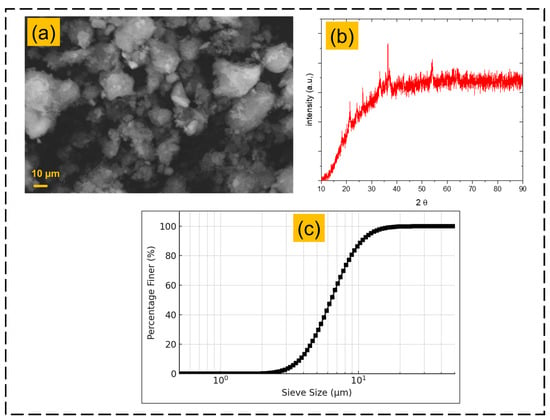
Figure 1.
Red mud properties: (a) SEM image, (b) XRD pattern, and (c) particle size.
2.2. Fibre Treatment
The banana and sisal fibres underwent alkali treatment using sodium hydroxide (NaOH) to eliminate impurities, hemicellulose, and wax, thereby improving their crystalline structure and adhesion to the matrix. The fibres were treated by soaking in sodium hydroxide solutions with concentrations of 0%, 2%, 4%, and 6% for a duration of six hours. After treatment, they were thoroughly washed, sun-dried, and then subjected to oven drying at 80 °C for four hours. Finally, the dried fibres were manually cut into 8 mm lengths.
2.3. Composite Fabrication
The composites were manufactured using the compression moulding process. The fibres were initially positioned within a steel mould measuring 300 × 300 × 3 mm3. In accordance with the supplier’s guidelines, epoxy and hardener were blended in a 10:1 ratio. The resulting matrix was subsequently poured over the fibres arranged in the mould. The mould was subsequently closed and subjected to a compression pressure of 20 MPa at 120 °C for 12 h. Once curing was complete, the composite samples were demoulded and trimmed to the specified dimensions in accordance with ASTM standards for subsequent testing and evaluation. Figure 2 illustrates the composite fabrication process.
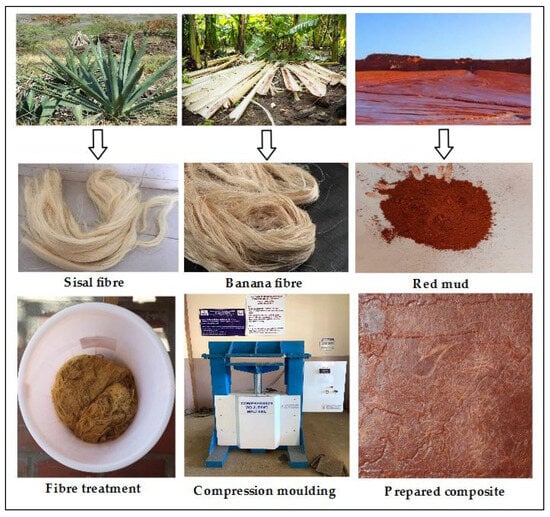
Figure 2.
Composite fabrication methodology followed.
A Taguchi-based (GRA) was employed to optimise the process parameters. An L16 orthogonal array with mixed levels for four different parameters was constructed using the Taguchi method, resulting in the production of 16 distinct composite specimens. Table 1 presents the selected parameters and their corresponding levels.

Table 1.
Process parameters and their levels.
2.4. Testing
Tensile testing of the composite specimens was conducted according to ASTM D3039 [] standards, using samples sized 25 mm × 250 mm. A UTM (Instron 5967) with a load capacity of 30 kN was used at a constant crosshead speed of 2 mm/min. The equipment was sourced from Instron, Norwood, MA, USA. Flexural strength was measured following ASTM D790–10 [], using samples sized 12.7 mm × 125 mm, and the same machine was used for the tests. Impact strength was evaluated with a Tinius Olsen Impact Tester (Model IT504), following ASTM D256–10 [] guidelines, using samples of size 64 mm × 12.7 mm. The equipment was sourced from Tinius Olsen, Horsham, PA, USA. Shear strength was determined based on ASTM D5379 [] using V-notched specimens, with the tests performed on the same UTM at a 2 mm/min crosshead speed. Hardness was assessed according to ASTM E18 [] using a Rockwell hardness tester with a B-scale setup. The test was carried out using a TRS-Rockwell B model, manufactured by Mitutoyo Corporation, located in Kawasaki, Japan. All mechanical testing was carried out at Metro Composite Lab, Chennai, Tamil Nadu, India. For each mechanical test, three samples were tested, and the average value was recorded for analysis.
To gain deeper insights into the failure mechanisms of the composites, SEM was performed on the fractured surfaces of tensile-tested specimens. The imaging was performed using a TSCAN Floor Model SEM in Secondary Electron (SE) mode, which provided detailed surface morphology. The equipment was manufactured by TESCAN ORSAY HOLDING a.s., located in Brno, Czech Republic. Before imaging, a thin gold coating was applied to the samples using sputter coating to enhance electrical conductivity and improve image resolution. The SEM was operated at an accelerating voltage of 30 kV, using a tungsten filament as the electron source. The instrument was also equipped with a Backscattered Electron (BSE) detector for contrast imaging and an Energy Dispersive Spectroscopy (EDS) system from EDAX Inc., Mahwah, NJ, USA, to analyse elemental composition.
2.5. Optimising Results with GRA
The Taguchi design of experiments was utilised to assess how control parameters affect the response variables. Its primary objective is to enhance quality efficiently in terms of time and cost. Using Taguchi’s orthogonal arrays allows for a significant reduction in the number of experiments while maintaining statistical reliability. This technique facilitates systematic analysis and optimisation of multiple process parameters to determine the optimal conditions. In this method, outcomes are transformed into S/N ratios, which assist in pinpointing the key factors affecting performance. S/N ratios are interpreted according to the desired outcome of the process, whether aiming for consistency around a specific value, minimising the response, or enhancing it to the highest possible level [].
2.6. Ratio of Signal to Noise
In this research, the parameter exhibiting the highest S/N ratio was chosen for analysis. The impact, tensile, and flexural strengths of natural composites reinforced with banana fibre (BF) and sisal fibre (SF) were assessed by the “larger-the-better” criterion during material characterisation. The corresponding S/N ratios were determined using Equation (1) [].
In the equation, y indicates the number of replications and Zab refers to the observed outcome for each trial, where a and b range from 1 to y.
2.7. Normalised S/N Ratio
Normalisation, also called standardisation, is a process applied to individual data points to evenly scale and distribute values, making subsequent analysis more effective. The variable xij is normalised within the range of 0 to 1 (i.e., 0 ≤ Zij ≤ 1) using Equation (2) [] to balance the effects of different measurement units and minimise variability.
2.8. Grey Relational Coefficients and Its Grades
Based on the normalised S/N ratios, Equation (3) was used to calculate the grey relational coefficient. Subsequently, the grey relational grade was obtained by combining these coefficients, as shown in Equation (4) [].
In this context, γj signifies the GRG for the jth experiment, while k indicates the performance index.
3. Results and Discussion
Table 2 details the L16 orthogonal array alongside the experimental results, while Table 3 displays the S/N ratios and normalised S/N values for the hybrid composites.

Table 2.
L16 orthogonal array and results of mechanical properties.

Table 3.
S/N ratio and normalised S/N ratio of the composites (mechanical properties).
3.1. Impact Strength
The maximum impact strength of 6.57 J was recorded in the 10th experiment, which used 30 wt.% sisal fibre, 15 wt.% banana fibre, 6% NaOH treatment, and 3 wt.% red mud. This combination created a balanced reinforcement system. Sisal fibres, known for their stiffness and strength, helped bear loads effectively, while banana fibres added flexibility and toughness. The hybrid structure allowed the composite to benefit from the individual strengths of both fibres, resulting in improved impact resistance. In contrast, the lowest impact strength of 1.98 J was observed in the 1st experiment, which had no natural fibres, no NaOH treatment, and only 1 wt.% red mud. Without the reinforcing fibres, the composite lacked the structural support needed for strong mechanical performance []. The results showed that increasing the NaOH concentration and red mud content generally led to higher impact strength. Figure 3 illustrates the impact strength of the composites under various processing conditions. The best impact performance, based on the S/N ratio, was achieved with 45 wt.% sisal fibre, 15 wt.% banana fibre, 6% NaOH treatment, and 4 wt.% red mud. Raising the fibre content from 15 wt.% to 30 wt.% significantly improved the impact strength. This is likely due to the increased surface area for bonding between the fibres and the matrix, which enhances fibre–matrix interaction. Better adhesion allows stress to be transferred more effectively, helping the composite absorb and spread impact energy. Arumuga Prabu et al. [] examined the mechanical behaviour of polyester composites reinforced with sisal and banana fibres and filled with red mud. Their findings indicated that the addition of red mud enhanced both impact and flexural strengths. Specifically, sisal fibre composites exhibited a maximum impact strength of 11 J, while banana fibre composites showed 6 J. The study also noted that sisal fibres provided better impact strength compared to banana fibres, attributed to stronger fibre–matrix bonding.
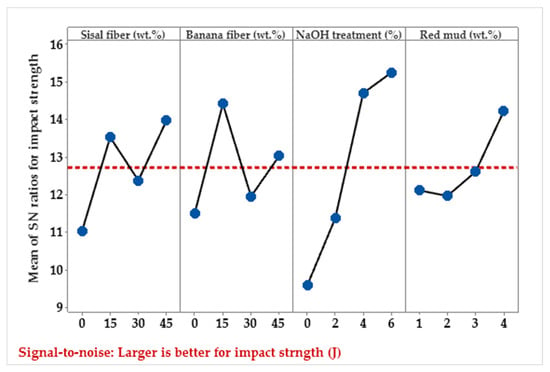
Figure 3.
Impact strength.
3.2. Flexural Strength
The maximum flexural strength of 72.58 MPa was recorded in the 13th experiment, which used 45 wt.% sisal fibre, no banana fibre, 6% NaOH treatment, and 2 wt.% red mud. The high amount of sisal fibre contributed substantially to increasing the flexural strength of the fabricated composite. Sisal fibres are strong and stiff, helping the material carry more load when bent. The 6% NaOH treatment cleaned the fibre surface and made it rougher, which improved bonding with the matrix. This stronger connection between fibre and matrix helped the composite resist bending forces more effectively. Adding 2 wt.% red mud also improved the flexural strength by acting as a filler. Red mud helped increase the density of the composite and reduced defects like air gaps, which are important for maintaining high strength. Figure 4 shows the flexural strength of the composites under different conditions, based on the S/N ratio. When the sisal fibre content increased from 15 to 30 wt.%, the S/N ratio dropped slightly (from 35.94 to 35.47). This may be due to fibre crowding, which can block proper stress transfer. However, increasing the sisal content from 30 to 45 wt.% improved fibre distribution in the matrix, raising the S/N ratio from 35.47 to 36.89 and boosting the composite’s load-bearing ability. For banana fibre, the S/N ratio rose from 35.19 to 36.30 as the content increased from 0 to 15 wt.%. It then dropped slightly to 35.88 at 30 wt.%, likely due to fibre overcrowding, and increased again to 36.83 at 45 wt.%, suggesting improved bonding between the matrix and the fibres at higher loading. The S/N ratio also increased with higher NaOH concentrations, showing that stronger fibre treatment helped the composite perform better. Increases in red mud from 1 to 2 wt.% and from 3 to 4 wt.% also led to better S/N ratios, indicating improved matrix properties. In summary, the best flexural strength was achieved with a composition containing 45 wt.% each of sisal and banana fibre, 6% NaOH treatment, and 4 wt.% red mud.
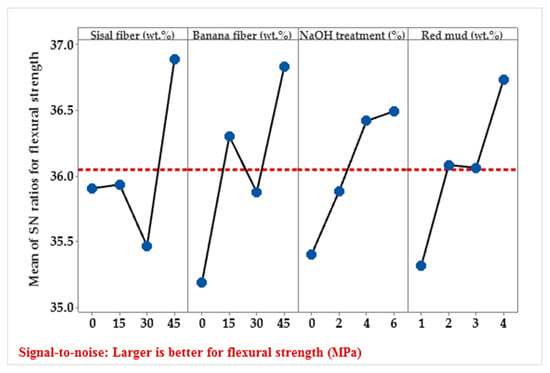
Figure 4.
Flexural strength.
3.3. Tensile Strength
The highest tensile strength of 65.52 MPa was achieved in the 10th experiment, where the optimal combination of variables was 30 wt.% sisal fibre, 15 wt.% banana fibre, 6% NaOH treatment, and 3 wt.% red mud. This specific formulation demonstrated a synergistic effect, maximising the tensile strength of the composite. The selected fibre content provided a balanced reinforcement, while the NaOH treatment likely enhanced the fibre–matrix adhesion, resulting in improved load transfer. Additionally, the inclusion of red mud further contributed to the mechanical properties by enhancing the composite’s structural integrity. This combination highlights the importance of optimising the composition and surface treatment for achieving superior mechanical performance in fibre-reinforced composites. The lowermost tensile strength of 26.81 MPa was obtained at 0 wt.% of sisal fibre, banana fibre, 0% of NaOH treatment and 1 wt.% of red mud. The lowest tensile strength of 26.81 MPa was recorded in the 1st experiment, characterised by the absence of sisal fibre and banana fibre (0 wt.%), no NaOH treatment (0%), and a minimal inclusion of 1 wt.% red mud. This configuration indicates a significant lack of reinforcement within the composite, as the absence of natural fibres resulted in reduced structural integrity and load-bearing capacity. Furthermore, the absence of NaOH treatment likely impaired the bonding between the matrix and any available fillers, exacerbating the material’s weakness. The limited amount of red mud also contributed to the overall inferior mechanical performance. Maurya et al. [] recently examined the thermo-mechanical and viscoelastic properties of linear low-density polyethylene composites reinforced with sisal/banana fibres, processed using microwave techniques. The study found that the sisal and banana fibre hybrid composite demonstrated improved mechanical properties, achieving tensile strength of 22.82 MPa, flexural strength of 15.87 MPa, and impact strength of 254.35 J/m. These results highlight the effectiveness of hybridisation and advanced processing techniques in improving composite performance. These results further support the idea that combining natural fibres and using advanced processing methods can significantly improve composite performance.
Figure 5 shows the tensile strength of the composites under different conditions, based on the S/N ratio. The results indicate that increasing sisal fibre content up to 45 wt.% leads to a clear improvement in tensile strength, as shown by the highest S/N ratio at this level. A similar trend is seen with banana fibre, where noticeable peaks appear at 15 wt.% and again at 45 wt.%, suggesting these fibre levels contribute to better mechanical performance. NaOH treatment had the most consistent and positive effect. Higher percentages of NaOH treatment improved the S/N ratio, showing that surface treatment of fibres enhances bonding with the matrix and improves tensile strength. Red mud also helped improve tensile properties. The highest S/N ratio for red mud was found at 4 wt.%, suggesting that it supports the structure by filling gaps and increasing the composite’s strength. Overall, the graph highlights the importance of selecting the right combination of fibre content, chemical treatment, and filler loading to improve the tensile strength of the composite. The tensile stress–strain curve shown in Figure 6 demonstrates a linear increase up to the peak, indicating elastic behaviour. After reaching the maximum stress, the composite fractures suddenly, reflecting its brittle nature.
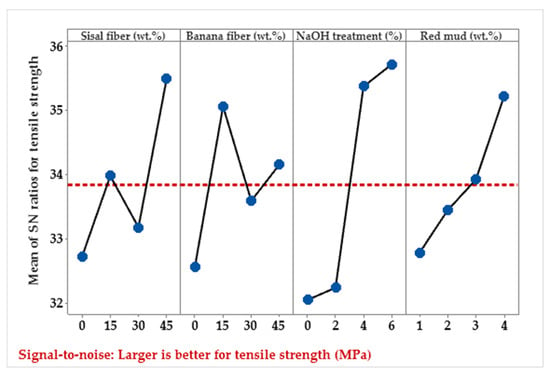
Figure 5.
Tensile strength.
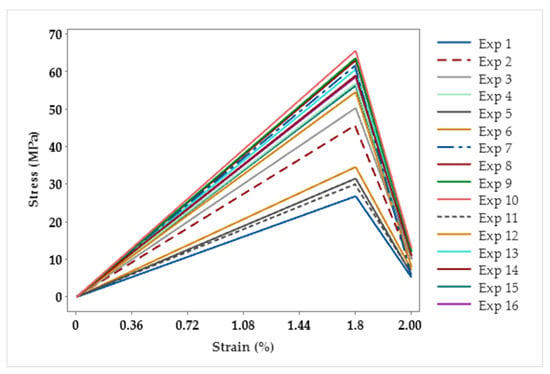
Figure 6.
Stress–strain curve.
3.4. Shear Strength
Figure 7 presents the shear strength of the fabricated composites with different influencing parameters. The influence of various process parameters on the shear strength of the composite was analysed using a Taguchi-based S/N ratio plot, adopting the “larger is better” criterion. The main effects plot revealed that all four parameters (sisal fibre content, banana fibre content, NaOH treatment percentage, and red mud content) significantly affected the shear strength. Among them, an increasing trend in S/N ratios was observed with the rise in sisal fibre content, reaching a maximum at 45 wt.%. Similarly, banana fibre exhibited a positive influence, with 15 wt.% providing the highest S/N ratio despite a slight dip at 30 wt.%. NaOH treatment showed a steep improvement in S/N ratios, with 6% treatment yielding the most favourable response, indicating enhanced fibre–matrix interfacial bonding. Red mud content also demonstrated a progressive increase in S/N ratios, with 4 wt.% offering the best performance. Overall, the optimal parameter combination for maximising shear strength was identified as 45 wt.% sisal fibre, 45 wt.% banana fibre, 6% NaOH treatment, and 4 wt.% red mud.
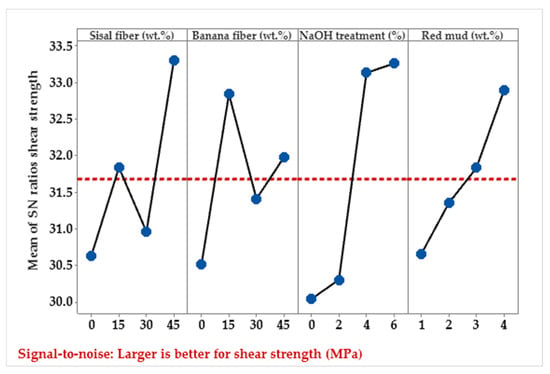
Figure 7.
Shear strength.
3.5. Hardness
Figure 8 illustrates the hardness of the composites with different influencing parameters. The effect of key process parameters on the hardness of the developed composite was analysed using a Taguchi-based S/N ratio plot, adopting the “larger is better” criterion. The main effects plot revealed that sisal fibre content, banana fibre content, NaOH treatment percentage, and red mud content significantly influenced the hardness values. An increasing trend was observed in S/N ratios with the rise in sisal fibre content, with 45 wt.% yielding the highest value, which can be attributed to the inherent rigidity and effective stress transfer capability of sisal fibres at higher concentrations. Banana fibre showed an initial sharp improvement in S/N ratio at 15 wt.%, followed by a slight drop and recovery, indicating that moderate levels promote better dispersion and hardness. The maximum S/N ratio for NaOH treatment was observed at 4%, suggesting that this level provides optimal surface modification of fibres, enhancing matrix adhesion and resistance to indentation, while higher treatment levels may degrade fibre quality. Red mud content improved hardness up to 1–2 wt.% due to the presence of hard ceramic-like particles that act as micro-fillers, although excessive filler content beyond this range may lead to agglomeration and void formation, adversely affecting the composite’s integrity. These findings are in agreement with Rasu et al. [], who reported that the incorporation of red mud as a filler in natural fibre-reinforced composites enhances hardness and wear resistance due to its high mineral content and fine particle dispersion. Thus, the optimal combination for maximum hardness was found to be 45 wt.% sisal fibre, 15 wt.% banana fibre, 4% NaOH treatment, and 1–2 wt.% red mud.
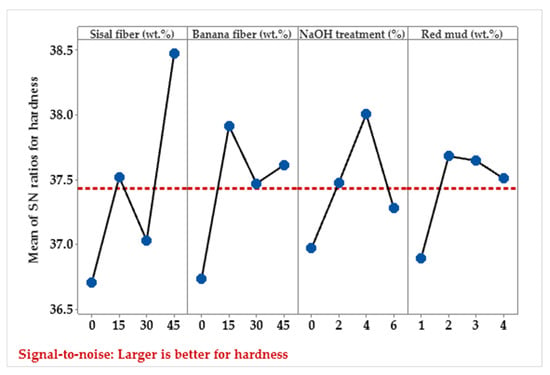
Figure 8.
Hardness.
3.6. Response Table for SN Ratio for Mechanical Properties
Performance characteristics of the hybrid composites were evaluated with varying compositions of sisal fibre, banana fibre, NaOH treatment, and red mud and presented in Table 4. Among all the factors studied, NaOH treatment had the most significant impact on mechanical performance, particularly in improving impact strength, tensile strength, and shear strength, as indicated by the highest delta (Δ) values and Rank 1 in these categories. This highlights the effectiveness of alkali treatment in enhancing fibre–matrix adhesion, thereby improving load transfer and resistance to failure. Sisal fibre showed consistent performance across most properties, ranking second in impact, tensile, and shear strength, and first in hardness, suggesting its strong contribution to both bulk and surface mechanical behaviour. Banana fibre also demonstrated a moderate effect, particularly notable in flexural strength where it ranked first, likely due to its inherent flexibility and structural characteristics. Red mud, though beneficial as a filler, showed the least influence on mechanical property variation, consistently ranking fourth across all categories. The results clearly indicate that surface treatment of fibres plays a more dominant role than mere inclusion of fillers in enhancing the mechanical properties of composites reinforced with natural fibre.

Table 4.
Response table for SN ratio for mechanical properties.
3.7. ANOVA for Mechanical Properties
The ANOVA results for mechanical properties reveal that NaOH treatment significantly influences impact, tensile, and shear strength, indicated by relatively higher F-values (6.82, 3.86, and 3.68, respectively) and lower p-values (close to 0.05) as shown in Table 5. Although not statistically significant at the 95% confidence level (p < 0.05), it shows a stronger effect compared to other parameters. Sisal and banana fibres contribute moderately to all mechanical properties but with high p-values (p > 0.35), indicating limited individual influence. Red mud shows minimal effect across all responses, especially in hardness, where none of the factors, including red mud, had a notable impact (p > 0.6). Overall, alkali treatment (NaOH%) appears to be the most influential factor in improving mechanical performance, though not yet statistically significant, warranting further focused optimisation.

Table 5.
ANOVA for mechanical properties.
3.8. Response of Sisal Fibre- and Banana Fibre-Reinforced Hybrid Composites
The grey relational coefficient (GRC), GRG, and grey relational ranking for each trial in the L16 orthogonal array were computed and are summarised in Table 6. Combining the Taguchi method with GRA enabled the transformation of a multi-response optimisation challenge into a single-response optimisation problem.

Table 6.
Grey relational coefficients, grade, and rank.
The levels A4, B2, C4, and D4 showed the highest GRG values for the different factors tested, namely, the weight percentages of sisal fibre, banana fibre, NaOH concentration, and red mud. These results are presented in Figure 9. The analysis confirms that the best combination for optimising the hybrid composite involves 45 wt.% sisal fibre, 15 wt.% banana fibre, 6% NaOH treatment, and 4 wt.% red mud. The figure illustrates the response of the composite to changes in these parameters. Sisal fibre is well known for its high tensile strength and stiffness, which provide strong reinforcement to the composite []. Using 45 wt.% offers enough reinforcement while still keeping the matrix workable. This level achieves a balance between good mechanical performance and ease of processing, allowing the composite to maintain its structure under load. Although banana fibre is not as strong as sisal, it adds flexibility and improves the ductility of the composite. At 15 wt.%, banana fibre complements the stiffness of sisal, resulting in a material with better impact resistance and reduced brittleness. This helps the hybrid composite absorb energy more effectively under stress. The 6% NaOH treatment plays an important role in cleaning the fibre surface by removing impurities, such as wax, lignin, and dust []. This improves the bonding between the fibre and the polymer matrix, allowing better stress transfer. The selected concentration of NaOH also ensures that the fibres remain strong and are not damaged during treatment, which helps maintain the overall performance of the composite.
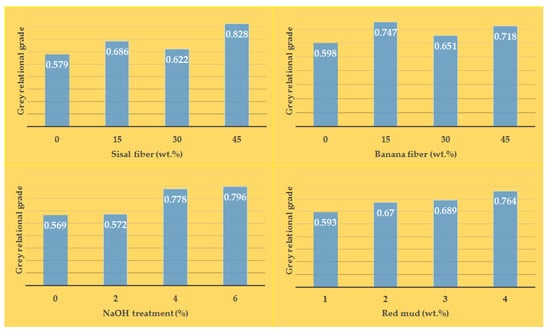
Figure 9.
The grey relational grade value of fabricated composites.
Red mud, an industrial waste from aluminium processing, was used as a filler to improve the composite’s properties. At 4 wt.%, it enhanced the mechanical, wear, and thermal behaviours of the material []. The red mud particles helped fill micro-voids and made the stress distribution more uniform. This low percentage ensured improved performance without reducing the composite’s flexibility or making it too brittle.
3.9. Microstructural Analysis of Sisal-Banana Fibre Hybrid Composites
The fractured surface microstructures of the composites were examined using SEM. The analysis focused on a composite containing 30 wt.% sisal fibre, 30 wt.% banana fibre, 2 wt.% red mud, and no NaOH treatment. Images taken at different magnifications are presented in Figure 10. The SEM results revealed the presence of voids and fibre pullout from the matrix. These features are mainly linked to the lack of NaOH treatment, which affected the bonding between the fibres and the matrix. Normally, NaOH treatment is used to clean the surface of natural fibres by removing unwanted substances such as lignin, hemicellulose, and waxes. These impurities can reduce the ability of the fibre to bond properly with the resin. In the absence of this treatment, the fibres kept their natural surface characteristics, which made it harder for the resin to wet and bond with them. This poor wetting led to the formation of small air gaps, or voids, within the composite. These voids can become weak points where stress builds up, reducing the strength of the material. Fibre pullout observed in the SEM images also indicates poor adhesion between the fibres and the matrix. When tensile force is applied, the fibres are pulled out instead of helping to carry the load. This weak fibre–matrix interface, especially in untreated fibres, prevents effective stress transfer, which lowers the overall mechanical performance of the composite.
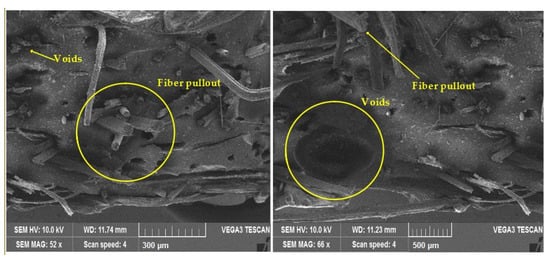
Figure 10.
SEM analysis of hybrid composites.
3.10. Sustainability and Cleaner Production Perspective
The integration of agricultural fibres and industrial waste in this study demonstrates a viable pathway toward sustainable composite development and cleaner production. The mechanical performance enhancements observed with increased sisal fibre content (up to 45 wt.%) and red mud loading (up to 4 wt.%) underscore the dual functionality of these reinforcements not only as structural contributors but also as environmental burden reducers. From a sustainability standpoint, the utilisation of sisal and banana fibres addresses the increasing need for renewable and biodegradable reinforcements. These fibres are sourced from agricultural residues, requiring minimal processing and generating negligible carbon emissions compared to synthetic alternatives. Their use aligns with bio-based material development policies and supports decentralised material supply chains in rural regions. The red mud filler, typically a waste stream from the aluminium refining process, presents significant ecological hazards due to its high alkalinity and heavy metal content. Incorporating red mud at optimised levels improved mechanical properties such as tensile, impact, and flexural strength while simultaneously diverting hazardous waste from landfill or tailing ponds. The uniform dispersion of red mud within the epoxy matrix contributed to void filling and increased densification, thus enhancing stress transfer and reducing composite porosity. Additionally, the application of the Taguchi–grey relational analysis (GRA) framework reduced the number of experimental iterations required, minimising material wastage and energy input. This statistical optimisation approach exemplifies a low-resource-intensive strategy for material development, which is critical for cleaner production workflows. The findings thus provide evidence for a circular materials approach, wherein agricultural and industrial residues are valorised into functional, high-performance engineering composites. These outcomes are particularly relevant for automotive, construction, and infrastructure applications, where demand for lightweight, strong, and environmentally compliant materials continues to grow. By strategically combining natural fibre hybridisation with industrial waste inclusion and process optimisation, this work offers a reproducible model for developing eco-functional composites in line with sustainable manufacturing principles.
4. Conclusions
The mechanical characterisation of the sisal–banana fibre hybrid composites revealed that the maximum impact strength of 6.57 J, flexural strength of 72.58 MPa, and tensile strength of 65.52 MPa were achieved with optimised compositions involving 30–45 wt.% sisal fibre, 15 wt.% banana fibre, 6% NaOH treatment, and 3–4 wt.% red mud. The Taguchi method, using S/N ratio analysis, identified NaOH treatment as the most influential parameter on mechanical performance, particularly for impact, tensile, and shear strength, as supported by high F-values (6.82, 3.86, 3.68) and p-values close to 0.05 in the ANOVA. However, the grey relational analysis (GRA) provided a more integrated assessment across all properties, yielding the highest grey grade (0.894) for the configuration in Experiment 13, which included 45 wt.% sisal fibre, 0 wt.% banana fibre, 6% NaOH, and 2 wt.% red mud. This confirms that while Taguchi is effective for analyzing individual responses, GRA is better suited for multi-objective optimisation of composite materials.
The study highlights that alkali treatment plays a dominant role in enhancing fibre–matrix adhesion, while hybridisation of natural fibres and judicious filler addition can synergistically improve overall performance. Based on the achieved mechanical properties, these optimised hybrid composites are particularly suitable for automotive interior panel applications, where moderate strength, reduced weight, and material sustainability are essential. Future work may focus on evaluating the long-term durability, thermal stability, biodegradability, and dynamic mechanical behaviour of these composites under real service conditions. Furthermore, integrating other sustainable fillers or nanomaterials could offer opportunities to enhance multi-functional properties such as fire resistance, acoustic insulation, and moisture resistance, broadening their industrial applicability.
Author Contributions
Conceptualization, K.R. and V.S.; methodology, V.S.; validation, K.R. and V.S.; formal analysis, V.S. and J.P.D.; investigation, V.S.; resources, K.R.; data curation, V.S.; writing—original draft preparation, K.R. and V.S.; writing—review and editing, J.P.D.; visualization, K.R.; supervision, J.P.D.; funding acquisition, K.R. All authors have read and agreed to the published version of the manuscript.
Funding
This research received no external funding.
Data Availability Statement
The data are available in the manuscript.
Conflicts of Interest
The authors declare no conflicts of interest.
References
- Rasu, K.; Veerabathiran, A. Characterization of Bauxite Residue Filled Sisal/Glass Fiber Reinforced Hybrid Composites for Structural Applications. Mater. Test. 2024, 66, 1911–1919. [Google Scholar] [CrossRef]
- Vigneshwaran, S.; Uthayakumar, M.; Arumugaprabu, V. Development and Sustainability of Industrial Waste-Based Red Mud Hybrid Composites. J. Clean. Prod. 2019, 230, 862–868. [Google Scholar] [CrossRef]
- Yang, M.; Chen, L.; Wang, J.; Msigwa, G.; Osman, A.I.; Fawzy, S.; Rooney, D.W.; Yap, P.-S. Circular Economy Strategies for Combating Climate Change and Other Environmental Issues. Environ. Chem. Lett. 2023, 21, 55–80. [Google Scholar] [CrossRef]
- Niu, A.; Lin, C. Trends in Research on Characterization, Treatment and Valorization of Hazardous Red Mud: A Systematic Review. J. Environ. Manage. 2024, 351, 119660. [Google Scholar] [CrossRef] [PubMed]
- Mandala, R.; Prasad, B.A.; Akella, S. Enhancing the Mechanical Properties of 3D-Printed Polylactic Acid through Pellet Additive Manufacturing: A Grey Relational Analysis Based on Entropy Weights. Int. J. Lightweight Mater. Manuf. 2025, 8, 331–340. [Google Scholar] [CrossRef]
- Tamilvendan, D.; Ravikumar, A.R.; Thirumalai, R. Parametric Optimization in Drilling of Sisal–Glass Reinforced Epoxy Composites Using Taguchi Grey Relational Analysis Method. Trans. Can. Soc. Mech. Eng. 2024, 48, 469–476. [Google Scholar] [CrossRef]
- Poyyathappan, K.; Kumar, A.G.; Venkatesan, K.; Rajaram, S. Optimization of Drilling Parameters for Alkali–Silane-Treated Areca Fiber–Epoxy Composites Using the Taguchi–Grey Relational Method. Polym. Bull. 2025. [Google Scholar] [CrossRef]
- Thangaraj, S.; kumar, A.R.; Vigneshwaran, M.; Muthuraj, M.; Shenbagaraj, R.; Girimurugan, R. Distinctive Study on Banana/Sisal Fiber Hybrid Composites Filled with Nano Marble Dust Particles. Mater. Today Proc. 2023. [Google Scholar] [CrossRef]
- Anbalagan, K.; Sarala, R.; Subramanian, S.; Yokesh, N.; Saravanan, N. Some Studies on Banana and Sisal Fibers-Based Hybrid Composites. Mater. Today Proc. 2023, 90, 140–144. [Google Scholar] [CrossRef]
- Kumari, N.; Paswan, M.; Prasad, K. Effect of Sawdust Addition on the Mechanical and Water Absorption Properties of Banana-Sisal/Epoxy Natural Fiber Composites. Mater. Today Proc. 2022, 49, 1719–1722. [Google Scholar] [CrossRef]
- Karthikeyan, R.; Pradeep, V.P. Investigation of Mechanical Behaviour on Natural Hybrid Fiber (Sisal/Banana) Reinforced with Epoxy Resin. Mater. Today Proc. 2022, 62, 2310–2314. [Google Scholar] [CrossRef]
- Devi, R.C.; Girimurugan, R.; Nanthakumar, S.; Rajasekaran, P.; Ahammad, S.K.H.; Gnanaraj, S.J.P. Experimental Study of Mechanical Properties of Sisal/Banana Fiber Hybrid Sandwich Composite. Mater. Today Proc. 2022, 68, 1793–1799. [Google Scholar] [CrossRef]
- Siva, R.; Kesavaram, B.; Martin, J.J.; Mathiselvan, G.; Navas, K.B.; Sangeetha, M. Mechanical Behavior of Sisal and Banana Fiber Reinforced Hybrid Epoxy Composites. Mater. Today Proc. 2021, 44, 3692–3696. [Google Scholar] [CrossRef]
- Gupta, U.S.; Dharkar, A.; Dhamarikar, M.; Kumrawat, A.; Giri, N.; Chauhan, A.R.S.; Giri, A.; Tiwari, S.; Namdeo, R. Investigation on Effects of Fiber Loading of Mechanical Properties of Banana/Sisal Hybrid Composite. Mater. Today Proc. 2021, 45, 7829–7837. [Google Scholar] [CrossRef]
- Rasu, K.; Veerabathiran, A. Performance of High Strength Natural Fiber Reinforced Hybrid Composites for Structural Engineering Applications. Mater. Test. 2025, 67, 553–560. [Google Scholar] [CrossRef]
- Karthick, R.; Anbumalar, V.; Vigneshkumar, M.; Samuel Gemsprim, M.; Venkatesh, R.; Dheenathayalan, P.; Selwin, M. Influence of Glass Fiber Hybridization on Flexural and Water Absorption Behaviour of Banana Fiber Reinforced Epoxy Composites. Mater. Today Proc. 2023. [CrossRef]
- Veerabathiran, A.; Palanichamy, R.; Rasu, K. Effect of Chitosan on Mechanical and Thermal Properties of Novel Aloe Vera Fiber Reinforced Composites. Mater. Test. 2024, 66, 867–875. [Google Scholar] [CrossRef]
- Rasu, K.; Veerabathiran, A. Influence of Betel Nut Fiber Hybridization on Properties of Novel Aloevera Fiber-Reinforced Vinyl Ester Composites. Mater. Test. 2024, 66, 1475–1482. [Google Scholar] [CrossRef]
- Karthick, R.; Adithya, K.; Hariharaprasath, C.; Abhishek, V. Evaluation of Mechanical Behavior of Banana Fibre Reinforced Hybrid Epoxy Composites. Mater. Today Proc. 2018, 5, 12814–12820. [Google Scholar] [CrossRef]
- Maurya, H.O.; Kumar, G.; Prasad, L.; Bisaria, H. Thermo-Mechanical and Viscoelastic Behavior of Microwave-Processed Sisal and Banana Hybrid Composite Laminates. J. Mater. Sci. 2024, 59, 20283–20303. [Google Scholar] [CrossRef]
- Rasu, K.; Veerabathiran, A. Effect of Red Mud on Mechanical and Thermal Properties of Agave Sisalana/Glass Fiber–Reinforced Hybrid Composites. Mater. Test. 2023, 65, 1879–1889. [Google Scholar] [CrossRef]
- Siva, R.; Reddy, S.; Aditya, K.; Sangeetha, M.; Karthik, N.; Joy, N. Investigation of Mechanical Properties of Different Arrangement on Sisal/Kenaf/Aloe Vera Hybrid Composites. Mater. Today Proc. 2021, 44, 3557–3563. [Google Scholar] [CrossRef]
- Ganesan, V.; Shanmugam, V.; Alagumalai, V.; Kaliyamoorthy, B.; Das, O.; Misra, M. Optimisation of Mechanical Behaviour of Calotropis Gigantea and Prosopis Juliflora Natural Fibre-Based Hybrid Composites by Using Taguchi-Grey Relational Analysis. Compos. Part C 2024, 13, 100433. [Google Scholar] [CrossRef]
- Bollino, F.; Giannella, V.; Armentani, E.; Sepe, R. Mechanical Behavior of Chemically-Treated Hemp Fibers Reinforced Composites Subjected to Moisture Absorption. J. Mater. Res. Technol. 2023, 22, 762–775. [Google Scholar] [CrossRef]
- Arumuga prabu, V.; Uthayakumar, M.; Manikandan, V.; Rajini, N.; Jeyaraj, P. Influence of Redmud on the Mechanical, Damping and Chemical Resistance Properties of Banana/Polyester Hybrid Composites. Mater. Des. 2014, 64, 270–279. [Google Scholar] [CrossRef]
- Radoor, S.; Karayil, J.; Rangappa, S.M.; Siengchin, S.; Parameswaranpillai, J. A Review on the Extraction of Pineapple, Sisal and Abaca Fibers and Their Use as Reinforcement in Polymer Matrix. Express Polym. Lett. 2020, 14, 309–335. [Google Scholar] [CrossRef]
- Balasubramaniam, S.; Ramalingam, R.; Rasu, K. Friction and Wear Behavior of Alkali-Treated Corn Husk Fiber Reinforced Polyester Composites. Mater. Test. 2025, 67, 543–552. [Google Scholar] [CrossRef]
- Rasu, K.; Veerabathiran, A. Tribological Behaviour of Industrial Waste Based Agave Sisalana/Glass Fiber Reinforced Hybrid Composites for Marine Applications. Mater. Test. 2023, 65, 593–602. [Google Scholar] [CrossRef]
Disclaimer/Publisher’s Note: The statements, opinions and data contained in all publications are solely those of the individual author(s) and contributor(s) and not of MDPI and/or the editor(s). MDPI and/or the editor(s) disclaim responsibility for any injury to people or property resulting from any ideas, methods, instructions or products referred to in the content. |
© 2025 by the authors. Licensee MDPI, Basel, Switzerland. This article is an open access article distributed under the terms and conditions of the Creative Commons Attribution (CC BY) license (https://creativecommons.org/licenses/by/4.0/).